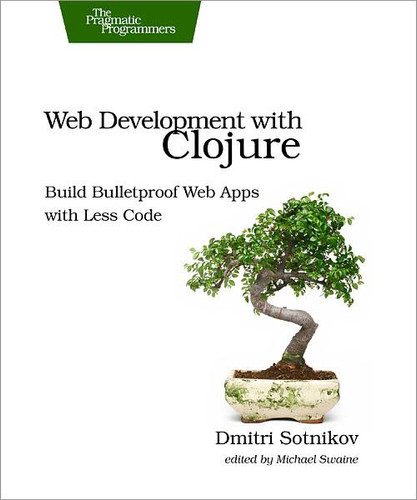0%
45Chapters
0-1Hours read
0kTotal Words
If the usual patchwork of web development tools and languages just isn't cutting it for you, you need Web Development With Clojure. Clojure gives you the rich infrastructure of the JVM with the expressive power of a modern functional language. It combines excellent performance with rapid development--and you can exploit these virtues for web app development. With step-by-step examples, you'll learn how to harness that power and richness to build modern web applications.
Table of Contents
- Web Development with Clojure
- Copyright
- For the Best Reading Experience...
- Table of Contents
- Early Praise for Web Development with Clojure
- Introduction
- What You Need
- Why Clojure?
- Why Make Web Apps in Clojure?
- Chapter 1: Getting Your Feet Wet
- Setting Up Your Environment
- Your First Project
- Chapter 2: Clojure Web Stack
- Routing Requests with Ring
- Defining the Routes with Compojure
- Application Architecture
- Beyond Compojure and Ring
- What You’ve Learned
- Chapter 3: Liberator Services
- Creating the Project
- Defining Resources
- Putting It All Together
- What You’ve Learned
- Chapter 4: Database Access
- Working with Relational Databases
- Report Generation
- What You’ve Learned
- Chapter 5: Picture Gallery
- The Development Process
- What’s in a Gallery
- Creating the Application
- Application Data Model
- Task A: Account Registration
- Task B: Login and Logout
- Task C: Uploading Pictures
- Task D: Displaying Pictures
- Task E: Deleting Pictures
- Task F: Account Deletion
- What You’ve Learned
- Chapter 6: Finishing Touches
- Adding Some Style
- Unit Tests
- Logging
- Application Profiles
- Packaging Applications
- What You’ve Learned
- Chapter 7: Mixing It Up
- Using Selmer
- Upgrading to ClojureScript
- SQL Korma
- Creating Application Templates
- What You’ve Learned
- Appendix 1: Alternative IDE Options
- Installing Eclipse
- Installing Emacs
- Alternatives
- Appendix 2: Clojure Primer
- A Functional Perspective
- Data Types
- Using Functions
- Anonymous Functions
- Named Functions
- Higher-Order Functions
- Closures
- Threading Expressions
- Being Lazy
- Structuring the Code
- Destructuring Data
- Namespaces
- Dynamic Variables
- Calling Out to Java
- Calling Methods
- Dynamic Polymorphism
- What about Global State?
- Writing Code That Writes Code for You
- The Read-Evaluate-Print Loop
- Summary
- Appendix 3: Document-Oriented Database Access
- Picking the Right Database
- Using CouchDB
- Using MongoDB
- You May Be Interested In…
